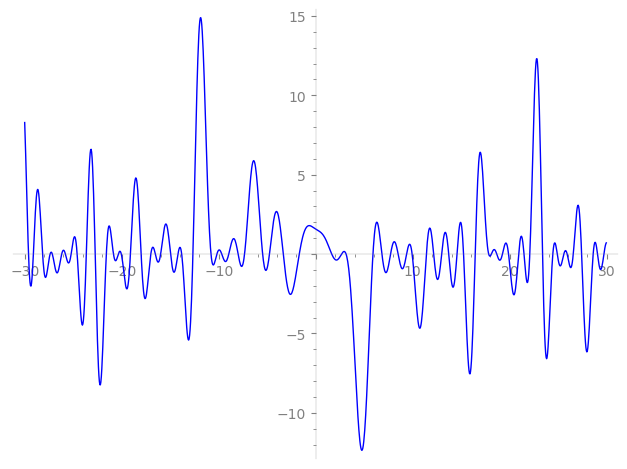| L(s) = 1 | + (−1.20 + 0.743i)2-s + (2.30 + 2.30i)3-s + (0.895 − 1.78i)4-s + (1.94 − 1.94i)5-s + (−4.48 − 1.05i)6-s − 3.32i·7-s + (0.252 + 2.81i)8-s + 7.60i·9-s + (−0.895 + 3.78i)10-s + (−1.35 + 1.35i)11-s + (6.17 − 2.05i)12-s + (−1.10 − 1.10i)13-s + (2.47 + 4.00i)14-s + 8.96·15-s + (−2.39 − 3.20i)16-s + 4.57·17-s + ⋯ |
| L(s) = 1 | + (−0.850 + 0.525i)2-s + (1.32 + 1.32i)3-s + (0.447 − 0.894i)4-s + (0.870 − 0.870i)5-s + (−1.82 − 0.432i)6-s − 1.25i·7-s + (0.0891 + 0.996i)8-s + 2.53i·9-s + (−0.283 + 1.19i)10-s + (−0.408 + 0.408i)11-s + (1.78 − 0.593i)12-s + (−0.305 − 0.305i)13-s + (0.661 + 1.07i)14-s + 2.31·15-s + (−0.599 − 0.800i)16-s + 1.10·17-s + ⋯ |
\[\begin{aligned}\Lambda(s)=\mathstrut & 368 ^{s/2} \, \Gamma_{\C}(s) \, L(s)\cr =\mathstrut & (0.510 - 0.860i)\, \overline{\Lambda}(2-s) \end{aligned}\]
\[\begin{aligned}\Lambda(s)=\mathstrut & 368 ^{s/2} \, \Gamma_{\C}(s+1/2) \, L(s)\cr =\mathstrut & (0.510 - 0.860i)\, \overline{\Lambda}(1-s) \end{aligned}\]
Particular Values
| \(L(1)\) |
\(\approx\) |
\(1.36667 + 0.778281i\) |
| \(L(\frac12)\) |
\(\approx\) |
\(1.36667 + 0.778281i\) |
| \(L(\frac{3}{2})\) |
|
not available |
| \(L(1)\) |
|
not available |
\(L(s) = \displaystyle \prod_{p} F_p(p^{-s})^{-1} \)
| $p$ | $F_p(T)$ |
|---|
| bad | 2 | \( 1 + (1.20 - 0.743i)T \) |
| 23 | \( 1 + iT \) |
| good | 3 | \( 1 + (-2.30 - 2.30i)T + 3iT^{2} \) |
| 5 | \( 1 + (-1.94 + 1.94i)T - 5iT^{2} \) |
| 7 | \( 1 + 3.32iT - 7T^{2} \) |
| 11 | \( 1 + (1.35 - 1.35i)T - 11iT^{2} \) |
| 13 | \( 1 + (1.10 + 1.10i)T + 13iT^{2} \) |
| 17 | \( 1 - 4.57T + 17T^{2} \) |
| 19 | \( 1 + (-2.70 - 2.70i)T + 19iT^{2} \) |
| 29 | \( 1 + (-4.52 - 4.52i)T + 29iT^{2} \) |
| 31 | \( 1 + 9.00T + 31T^{2} \) |
| 37 | \( 1 + (0.166 - 0.166i)T - 37iT^{2} \) |
| 41 | \( 1 + 11.1iT - 41T^{2} \) |
| 43 | \( 1 + (1.75 - 1.75i)T - 43iT^{2} \) |
| 47 | \( 1 + 9.50T + 47T^{2} \) |
| 53 | \( 1 + (3.17 - 3.17i)T - 53iT^{2} \) |
| 59 | \( 1 + (-1.45 + 1.45i)T - 59iT^{2} \) |
| 61 | \( 1 + (9.07 + 9.07i)T + 61iT^{2} \) |
| 67 | \( 1 + (2.68 + 2.68i)T + 67iT^{2} \) |
| 71 | \( 1 - 3.42iT - 71T^{2} \) |
| 73 | \( 1 + 7.15iT - 73T^{2} \) |
| 79 | \( 1 + 6.02T + 79T^{2} \) |
| 83 | \( 1 + (-3.30 - 3.30i)T + 83iT^{2} \) |
| 89 | \( 1 + 8.26iT - 89T^{2} \) |
| 97 | \( 1 + 16.0T + 97T^{2} \) |
| show more | |
| show less | |
\(L(s) = \displaystyle\prod_p \ \prod_{j=1}^{2} (1 - \alpha_{j,p}\, p^{-s})^{-1}\)
Imaginary part of the first few zeros on the critical line
−10.79570586661599448805649874546, −10.18568967527695655460149711211, −9.685955407573264955095331163145, −8.963558377448202208681362607037, −8.000552126367223269187124996785, −7.33745289084286792091530371004, −5.47158322461294417567298966531, −4.76883718055938436399819451647, −3.34500214807023177412935004351, −1.69515607631297657704701872804,
1.64893335918980742648644627753, 2.66184673809490647921617798013, 3.12801370766671834143326348038, 5.90043033186364399351628879007, 6.82463652400945031220146636004, 7.71505200661986847930275078336, 8.493232066887277978742159775380, 9.368220142526051822793270659520, 9.936627417494881450783400853813, 11.40271282980868454962753419627

